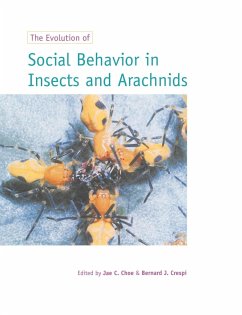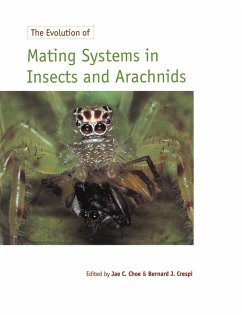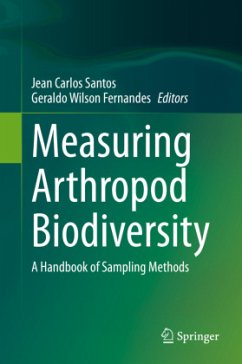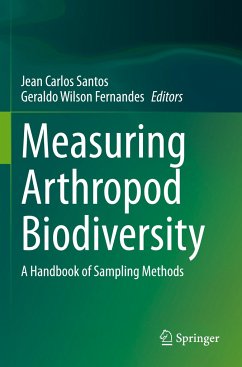
Identifying British Insects and Arachnids
Versandkostenfrei!
Versandfertig in 1-2 Wochen
134,99 €
inkl. MwSt.

PAYBACK Punkte
67 °P sammeln!
Until now, individuals wishing to identify British insects have found it difficult to track down the specialist keys published in obscure literature, whereas the popular guides are often misleadingly simplistic, covering only a fraction of the species. This book bridges the gap, providing expert guidance through the taxonomic maze. It contains an introduction to each group of organisms, and over 2000 references selected as being the most useful and up-to-date for accurate identification, together with notes on their relevance and coverage. A further chapter covers the understanding and retriev...
Until now, individuals wishing to identify British insects have found it difficult to track down the specialist keys published in obscure literature, whereas the popular guides are often misleadingly simplistic, covering only a fraction of the species. This book bridges the gap, providing expert guidance through the taxonomic maze. It contains an introduction to each group of organisms, and over 2000 references selected as being the most useful and up-to-date for accurate identification, together with notes on their relevance and coverage. A further chapter covers the understanding and retrieval of scientific references, with advice on using libraries and other information services. This will be an essential reference book for anyone involved in insect and arachnid identification, from interested amateurs to professionals dealing with unfamiliar groups.
Table of contents:
Introduction; Acknowledgements; 1. Sources of information Julie M. V. Harvey; 2. Collembola: the Springtails Peter C. Barnard; 3. Protura: the Proturans Peter C. Barnard; 4. Diplura: the Two-tailed Bristle-tails Peter C. Barnard; 5. Thysanura: the Silverfish and Firebrats Peter C. Barnard; 6. Archaeognatha: the Bristletails Peter C. Barnard; 7. Ephemeroptera: the Mayflies or Up-winged Flies Stephen J. Brooks; 8. Odonata: the Dragonflies and Damselflies Stephen J. Brooks; 9. Plecoptera: the Stoneflies Stephen J. Brooks; 10. Phasmida: the Stick-insects Judith A. Marshall; 11. Orthoptera: the Grasshoppers, Crickets and Bush-crickets Judith A. Marshall; 12. Dermaptera: the Earwigs Judith A. Marshall; 13. Blattodea: the Cockroaches Judith A. Marshall; 14. Psocoptera: the Booklice and Barklice Jon H. Martin; 15. Phthiraptera: the Lice Chris H. C. Lyal; 16. Thysanoptera: the Thrips Jon H. Martin; 17. Hemiptera: the True Bugs Jon H. Martin and Mick D. Webb; 18. Neuroptera: the Lacewings Peter C. Barnard; 19. Megaloptera the Alderflies Peter C. Barnard; 20. Raphidoptera: the Snakeflies Peter C. Barnard; 21. Coleoptera: the Beetles Peter M. Hammond and Stuart J. Hine; 22. Strepsiptera: the Stylops Peter M. Hammond and Stuart J. Hine; 23. Mecoptera: the Scorpionflies Peter C. Barnard; 24. Trichoptera: the Caddisflies Peter C. Barnard; 25. Lepidoptera: the Moths and Butterflies Mark A. Parsons, Gaden S. Robinson, Martin R. Honey, and David J. Carter; 26. Diptera: the Flies Nigel P. Wyatt and John E. Chainey; 27. Siphonaptera the Fleas Theresa M. Howard; 28. Hymenoptera: the Bees, Wasps and Ants John S. Noyes, Mike G. Fitton, Donald L. J. Quicke, David G. Notton, George R. Else, Nigel D. M. Ferguson, Barry Bolton, Suzanne Lewis and Laraine C. Tarel; 29. Pseudoscorpiones: the Pseudoscorpions Paul D. Hillyard; 30. Opiliones: the Harvestmen Paul D. Hillyard; 31. Araneae: the Spiders Paul D. Hillyard; 32. Acari: the Mites and Ticks Anne S. Baker; Index.
This book is an essential reference book for anyone, amateur or professional, needing to identify insects or arachnids to species. It includes descriptions, over 2000 of the most useful and up-to-date references, notes on coverage and relevance, and a chapter on how to use library and other information services to best effect.
Essential guide to the specialist literature for the identification of British insects and arachnids.
Table of contents:
Introduction; Acknowledgements; 1. Sources of information Julie M. V. Harvey; 2. Collembola: the Springtails Peter C. Barnard; 3. Protura: the Proturans Peter C. Barnard; 4. Diplura: the Two-tailed Bristle-tails Peter C. Barnard; 5. Thysanura: the Silverfish and Firebrats Peter C. Barnard; 6. Archaeognatha: the Bristletails Peter C. Barnard; 7. Ephemeroptera: the Mayflies or Up-winged Flies Stephen J. Brooks; 8. Odonata: the Dragonflies and Damselflies Stephen J. Brooks; 9. Plecoptera: the Stoneflies Stephen J. Brooks; 10. Phasmida: the Stick-insects Judith A. Marshall; 11. Orthoptera: the Grasshoppers, Crickets and Bush-crickets Judith A. Marshall; 12. Dermaptera: the Earwigs Judith A. Marshall; 13. Blattodea: the Cockroaches Judith A. Marshall; 14. Psocoptera: the Booklice and Barklice Jon H. Martin; 15. Phthiraptera: the Lice Chris H. C. Lyal; 16. Thysanoptera: the Thrips Jon H. Martin; 17. Hemiptera: the True Bugs Jon H. Martin and Mick D. Webb; 18. Neuroptera: the Lacewings Peter C. Barnard; 19. Megaloptera the Alderflies Peter C. Barnard; 20. Raphidoptera: the Snakeflies Peter C. Barnard; 21. Coleoptera: the Beetles Peter M. Hammond and Stuart J. Hine; 22. Strepsiptera: the Stylops Peter M. Hammond and Stuart J. Hine; 23. Mecoptera: the Scorpionflies Peter C. Barnard; 24. Trichoptera: the Caddisflies Peter C. Barnard; 25. Lepidoptera: the Moths and Butterflies Mark A. Parsons, Gaden S. Robinson, Martin R. Honey, and David J. Carter; 26. Diptera: the Flies Nigel P. Wyatt and John E. Chainey; 27. Siphonaptera the Fleas Theresa M. Howard; 28. Hymenoptera: the Bees, Wasps and Ants John S. Noyes, Mike G. Fitton, Donald L. J. Quicke, David G. Notton, George R. Else, Nigel D. M. Ferguson, Barry Bolton, Suzanne Lewis and Laraine C. Tarel; 29. Pseudoscorpiones: the Pseudoscorpions Paul D. Hillyard; 30. Opiliones: the Harvestmen Paul D. Hillyard; 31. Araneae: the Spiders Paul D. Hillyard; 32. Acari: the Mites and Ticks Anne S. Baker; Index.
This book is an essential reference book for anyone, amateur or professional, needing to identify insects or arachnids to species. It includes descriptions, over 2000 of the most useful and up-to-date references, notes on coverage and relevance, and a chapter on how to use library and other information services to best effect.
Essential guide to the specialist literature for the identification of British insects and arachnids.














